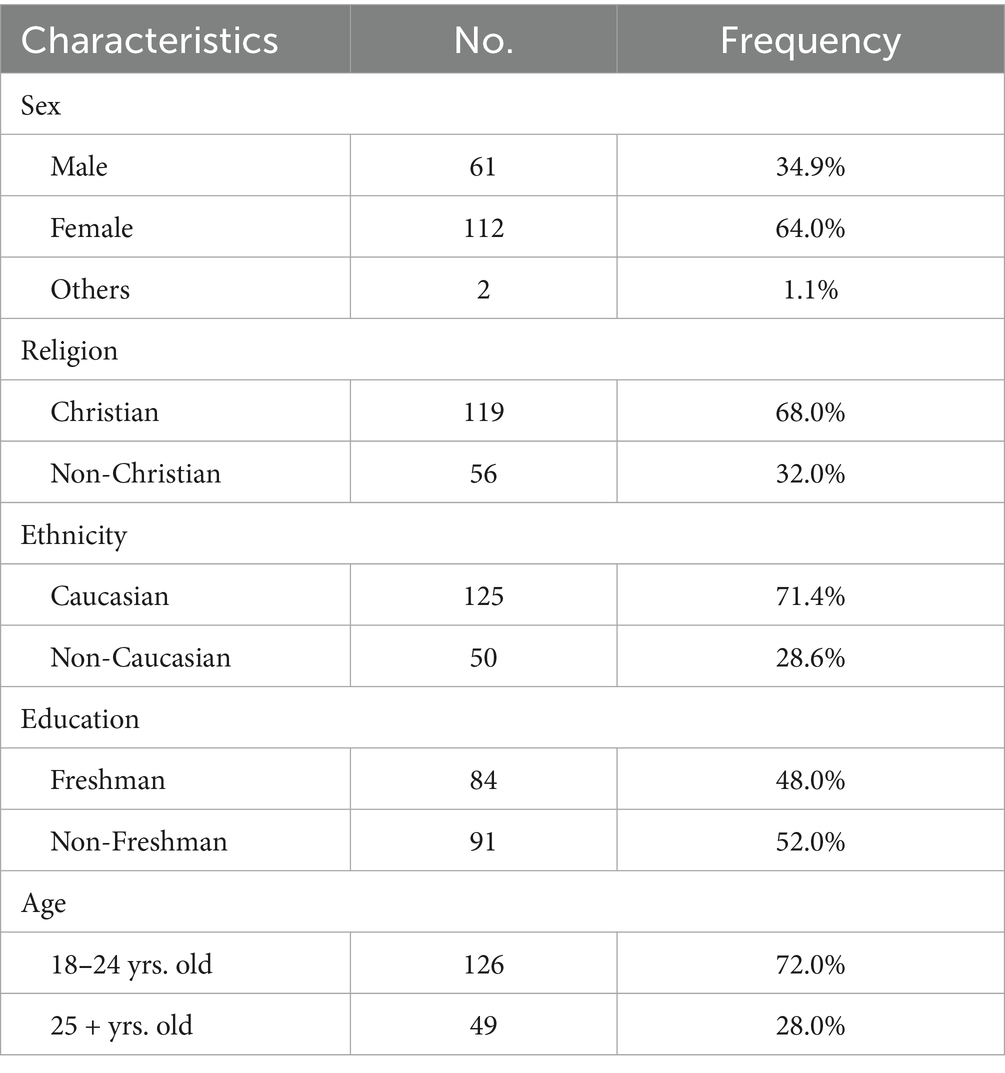- 1Department of Science (Biology), Crandall University, Moncton, NB, Canada
- 2Department of Graduate Studies, Crandall University, Moncton, NB, Canada
- 3School of Computer and Information Sciences, Hubei Engineering University, Xiaogan, China
Objective: During the COVID-19 pandemic, social media usage was rapidly accelerated by increased social isolation due to public health measures that attempted to limit the spread of the virus. Even though numerous studies indicate that increased screen usage during the pandemic is associated with negative mental health outcomes, there is no consensus on the effect of social media apps on mental health. This study investigated the impact of COVID-19 on the mental health of students attending a privately funded Christian university on their social media usage.
Methods: The data used for this study were collected using a cross-sectional survey involving 36.5% of the full-time undergraduates in the traditional Art Business and Science (ABS) undergraduate program at a privately funded Canadian Christian university.
Findings: Consistent with previous research, an increase in social media use and its detrimental impact on people’s mental health during COVID-19 that we identified indicates that social media greatly impacts undergraduates’ lives. COVID-19 aggravated social media usage in student groups with a lower mental health status. Nevertheless, moderate social media use on specific social platforms can promote mental health against social isolation and stress generated by the pandemic. In the post-COVID era, the residual pandemic impact was higher for participants with low mental health status. Furthermore, during the pandemic, religion appeared to be a protective factor against excessive screen use on social media.
Originality: This study examined the use of social media in a Christian university context and highlighted the effect of religion on the screen time of social media among students. To the best of our knowledge, this is the first such study.
Introduction
The recent COVID-19 pandemic has been undisputably most severe one since the Spanish flu pandemic of 1918. Apart from detrimental COVID-19 health outcomes, risk mitigation strategies and mandates during the pandemic, such as domestic confinement and widespread lockdown, led to a substantial increase in screen time, especially social media usage, among all age groups (Trott et al., 2022). Multiple cross-sectional and longitudinal studies prior to the pandemic indicated that excessive screen time is associated with premature neurodegeneration, chronic stress, increased number and severity of addictions, and mental health disorders (Kelly et al., 2018; Neophytou et al., 2021; Wang et al., 2019). Hence, along with an increase in screen time among Canadians during the pandemic, 25% of adults experience low-to-moderate health difficulties, and 9% experience severe mental health difficulties with symptoms such as psychological distress, depression, and anxiety (Guerrero and Barnes, 2022). Screen time has been classified as sedentary behavior, in which excessive usage might lead to adverse health outcomes in both physical and mental aspects (Tremblay et al., 2017; Saunders et al., 2020). The adverse outcomes of excessive screen time include premature neurodegeneration, chronic stress, increased number and severity of addictions, and mental health disorders (Neophytou et al., 2021; Wang et al., 2019). Regarding mental health, excessive screen time is associated with high sympathetic arousal and cortisol dysregulation, resulting in a negative correlation between stress regulation and screen time (Lissak, 2018). In addition, higher recreational screen time among the younger generations is associated with increased unhealthy psychological outcomes (Babic et al., 2017). Regarding physical health and general screen time, including the use of television, the Internet, video games, and mobile devices, higher screen usage correlated with an adverse impact on sleep, obesity, stress, and behavior, including lower self-regulation abilities (Leppänen et al., 2020). However, these studies that reported the negative impact of screen time on health employed an overall screen-time measure, neglecting possible differences across different types of digital media, technologies, and platforms. For instance, a recent study demonstrated that screen-based active social private usage was positively associated with decreased odds of self-injury and suicidal behavior (Kingsbury et al., 2021). Therefore, comparing the overall social media usage and most-used social media usage in association with mental health status in our study might be able to resolve the controversy as to whether social media usage has a negative or positive impact on college students’ mental health.
Upon considering and analyzing the current research, it becomes evident that no study has yet been performed on the mental health of students attending a privately funded Christian university in relation to their daily screen time usage before and after the COVID-19 pandemic. Does the screen time spent on social media, including novel apps, affect the overall mental health of students at a private Christian University? Could the previous studies in adolescents and youth, indicating that increased screen time throughout the COVID-19 pandemic contributed to lower levels of mental health status, be extrapolated to university-aged students at a private Christian University? If the answer is yes, it would be interesting to know whether the remnant COVID-19 impact on college students’ screen usage is associated with their mental health.
In this study, we used a PMH (Positive mental health) scale to test specifically for the presence of positive mental health status, which provides a more descriptive result of the individual being studied, and in turn, their true status of mental well-being (Lukat et al., 2016). The PMH scale is a nine-point Likert-type scale with a total score of 36 that can be defined as the culmination and presence of emotional, psychological, and social well-being to give the product of good mental health. It has been proven to be a valid instrument for measuring mental well-being in both the general population and clinical settings (Vaganian et al., 2022; Velten et al., 2022). Using the PMH-scale to quantify mental health status, our research explored the COVID-19 impact on mental health effects interacting with the novel social apps among young adults at (Anonymized) University before, during, and post-pandemic eras. We hypothesized that the pandemic’s influence would continue to impact social media usage among undergraduates in the category of low-PMH scores in the post-COVID era. This study will benefit the formulation and implementation of public health policy and guidance regarding social media in schools and colleges.
Literature review
The COVID-19 pandemic has had a significant impact on students’ mental health in colleges and universities (Xu and Yang, 2024). Many studies have shown that COVID-19 has aggravated delicate mental well-being states for a large number of students in colleges (Lovin and Bernardeau-Moreau, 2022; Barbayannis et al., 2022; Yang et al., 2022). The difficulties that the COVID-19 pandemic has brought are numerous, for example, isolation and lack of communication, due to the mass move to online course provisions. Although deploying technology to deliver distance learning is a valuable short-term solution, it has become a significant source of stress for students as the lockdown and isolation schemes have become protracted (Wang, 2023).
Students were among the biggest casualties of the pandemic in terms of mental health. They were more likely to be thousands of miles away from home, less likely to have relatives in the country of study to provide emotional support (Van De Velde, Buffel, et al., 2021); they were more likely to be in tight accommodation, with many renting rooms in student residences or private housing. Thus, significant research has recognized the mental health deterioration of international students. The mental health issues faced by students in higher education include acute stress, withdrawal, anxiety, and depression (Barbayannis et al., 2022; Hack-Polay and Read, 2019). In the context of COVID-19, international students have been particularly vulnerable due to being away from home, family, and friends, and having to adapt to a new social environment. Social issues, as well as ensuing anxiety, have been pointed out as significant mental health issues for students (Hack-Polay and Read, 2019; Yu and Wright, 2016).
Young college students might be more vulnerable to the COVID-19 pandemic-related mental health challenges, since their brain development, especially the development of the prefrontal lobe in charge of critical thinking and self-regulation, is not completed until around 25 years old (Casey et al., 2008). Recent studies have reported that increased screen usage is associated with higher levels of depression and a multitude of mental health defects in the adolescent population (Boers et al., 2019; Pandya and Lodha, 2021). Quantitative estimates for daily screen usage have increased in recent years, with studies reporting a range between 2.8–11.6 h per day in college students (Jasbi et al., 2022). Among all types of screen time in adolescent and young adults’ lives during the pandemic, social media usage has been the one that accelerated rapidly due to increased social isolation resulting from public health measures attempting to limit the spread of the virus (Li et al., 2021). Some studies have linked social media to negative psychological effects, including low self-esteem and life satisfaction, self-harming behaviors, and depressive symptoms (Woods and Scott, 2016; Twenge and Campbell, 2018; Hack-Polay, 2020). Others have pointed to the protective effects of social media usage on mental health (O’Reilly et al., 2019; Ngien and Jiang, 2022; Popat and Tarrant, 2022).
In order to investigate the relationship between mental health and screen time for social media affected by the COVID-19 epidemic, selecting an appropriate description and scaling system to define the term mental health is necessary, because mental health assessment scales vary greatly in terms of the components of mental health being examined. Recent findings suggest that in assessing the mental health status of an individual, it is not an effective practice to merely test for the presence or absence of mental illness. Instead, testing specifically for the presence of positive mental health status provides a more descriptive result of the individual being studied and, in turn, their true status of mental well-being (Lukat et al., 2016). Positive mental health (PMH), due to its single-concept measure, simplistic design, and high reliability, is a viable candidate for evaluating both the positive and negative mental health status of adolescent and young students, while it has proven to be a valid instrument in various genders and age groups across eight different countries (Velten et al., 2022). A review performed by Lukat et al. in 2016 revealed the consistency, retest-reliability, convergent and discriminant validity, sensitivity, and unidimensionality of the scale upon trial with a sample of 5,406 students (Lukat et al., 2016). The PMH scale is a nine-point Likert-type scale with a total score of 36, which can be defined as the culmination and presence of emotional, psychological, and social well-being to give the product of good mental health. It has been widely used to measure mental well-being in both the general population and in clinical settings (Vaganian et al., 2022). A recent study (Almubaddel, 2022) divided PMH scores into three categories, where higher scores (28–36) indicated higher positive mental health and lower scores (9–18) represented negative mental health.
Research on the mental health effects of interacting with novel apps such as TikTok, Pinterest, Instagram, Facebook, Twitter, and Snapchat is limited in the literature, which is pertinent to explore, given the rise in mental illnesses in Canada, especially among younger generations, coinciding with an increase in overall screen time following the effects of the COVID-19 pandemic.
Methods
Cross-sectional survey
A cross-sectional and descriptive study was conducted by email using a questionnaire link created with Google Forms to all full-time undergraduates in the traditional Art Business and Science (ABS) program at Crandall University from March to April 2023. The questionnaire was developed to investigate the effects of social media apps on mental wellness in the post-COVID-19 pandemic era, incorporating the Positive Mental Health Scale (Lukat et al., 2016), as well as questions regarding social media use and other lifestyle factors, in keeping with other survey-type experimental designs in this area of research (Leppänen et al., 2020; Royant-Parola et al., 2018). The questionnaire was designed to measure Positive Mental Health scores and habits related to screen time on social media, as well as other lifestyle factors. Database construction involved distributing the questionnaire formatted through Google Survey via email to the Crandall University student population. Within the schoolwide email, students were presented with an informed consent form, a brief description of the research at hand, a link to the questionnaire, and a description of their opportunity to voluntarily enter a prize draw for incentivization. The posters placed around the campus encouraged undergraduate students to scan QR codes and complete the questionnaire. Multiple other recruitment strategies, such as promoting surveys in various classes covering the majority of the undergraduates, social events, and using social media apps, were used to ensure a relatively large and diverse pool of participants. Assuring the respondents that their responses were kept confidential and anonymous further encouraged a more diverse pool of undergraduates to participate. Participation was voluntary, and participants chose to withdraw at any time.
Ethical approval
The study was approved by the Research Ethics Committee of Crandall University and conducted in accordance with the Helsinki Declaration.
Participants and study settings
Following proper instruction and anonymous assurance, 175 undergraduate students (36.5% of the total ABS student Full Time Equivalent (FTE), 479 students in total) provided consent and completed an online survey consisting of a demographic questionnaire, the PMH scale, self-rated screen time for social apps, and self-rated physical and recreational time. The respondents were advised to report their most-used social media platform based on their phone’s status of mobile apps. There were three extra students who completed the survey but refused to give their consent to participate in this research. Therefore, their data were not eligible for further analysis in this study. Questions about their preferred social media, motivation for screen usage, and the self-evaluated impact of social media on their current mental health were addressed in the survey.
Sample characteristics
The majority of participants were women (64%) and in their first year of study (48.3%), with a wide range of educational programs represented (Table 1). Most participants were identified as Christian (68%) and White (71.3%), with several other ethnicities and religions represented. The age of the participants varied: 18 (16.9%), 19 (16.3%), and 25 + years (27.5%). The undergraduates aged from 18 to 25 + years old, divided into two age groups: 18–24 and 25 + years old, respectively.
Health behaviors
Screen time was assessed by asking participants to estimate their daily average screen time use on all social media apps as well as their most-used social media app, similar to other studies for screen time (Colley et al., 2022; Statistics Canada, 2022). To measure the change in screen time on social media due to the effects of the COVID-19 pandemic, participants were asked to estimate their average time spent per day on the most-used social media app in 2019 (pre-COVID era), 2020–2021 (COVID era), and 2022-present (post-COVID era). Based on these responses, a numeric rating scale was constructed to quantify the average daily screen usage: 1 (less than 1 h), 2 (1–2 h), 3 (3–4 h), 4 (5–6 h), 5 (7–8 h), 6 (9–10 h), and 7 (11 + h).
Mental health PMH scale
The PMH scale was used to measure participants’ mental well-being. The instrument included nine items rated on a four-point Likert-type scale ranging from 1 (do not agree) to 4 (agree). The PMH total scores (range, 0–36, with higher scores indicating a more positive mental health status), have been found to be a sound measure of overall mental health from emotional, psychological, and social well-being aspects (Lukat et al., 2016). The total PMH scores of our sample ranged from 14 to 36, with a median of 27. According to the three-level PMH scale (Almubaddel, 2022), only a very small proportion (3.4%) of the participants in this study demonstrated negative mental health (with lower PMH scores ranging from 14 to 18), while the rest (96.6%) demonstrated positive or neutral mental health. Hence, we used a two-level category analysis to obtain better statistics in this study. Based on the median PMH scores in our sample, we categorized the sample into two levels: low PMH scores of 14–27 (accounting for 51.4% of the sample) and high PMH scores of 28–36 (accounting for 48.6% of the sample).
Statistical analysis
Sample characteristics were described using means and standard deviations for interval variables and percentages for the categorical variables, with differences tested using analysis of variance (ANOVA) and chi-square (Χ2), respectively. The characteristics (distributions, means, and variances) of screen usage in different COVID eras were explored using descriptive techniques, including graphs and descriptive statistics. Minimal data were missing because all data were obtained from participants who agreed to participate in this study. Daily screen usage for social media apps or daily activities (physical exercises and leisure activities), defined as the time period (h per day) spent, was used to analyze the probabilities of screen usage or activity transition in the baseline period (pre-COVID era), COVID, and post-COVID era, respectively. It allows for the estimation of the probabilities of all transitions, such as increased, the same, and decreased screen usage or activities during (2020–2021) and after the COVID-19 pandemic, in relation to mental health outcomes measured by the PMH scale. Data analyses were performed using SPSS v24.0.
Results
During the COVID-19 pandemic, the average daily screen usage for both total and most-used social media apps among 175 respondents at Crandall University was significantly higher than pre-COVID era (Table 2a; p < 0.001). In the post-COVID era, there were no significant differences in average daily screen usage for social media apps (p > 0.05) compared with the pre-COVID era. The majority of participants (60.5%) disagreed that less screen usage benefited their mental health, while a large proportion (40.6%) agreed that social media apps benefited their mental health during the COVID-19 era (Table 2b). Based on the self-rated investigation, screen usage of the majority (56.5%) did not affect their sleeping, while the majority (64.6%) did not use their mobile device to procrastinate their schoolwork.
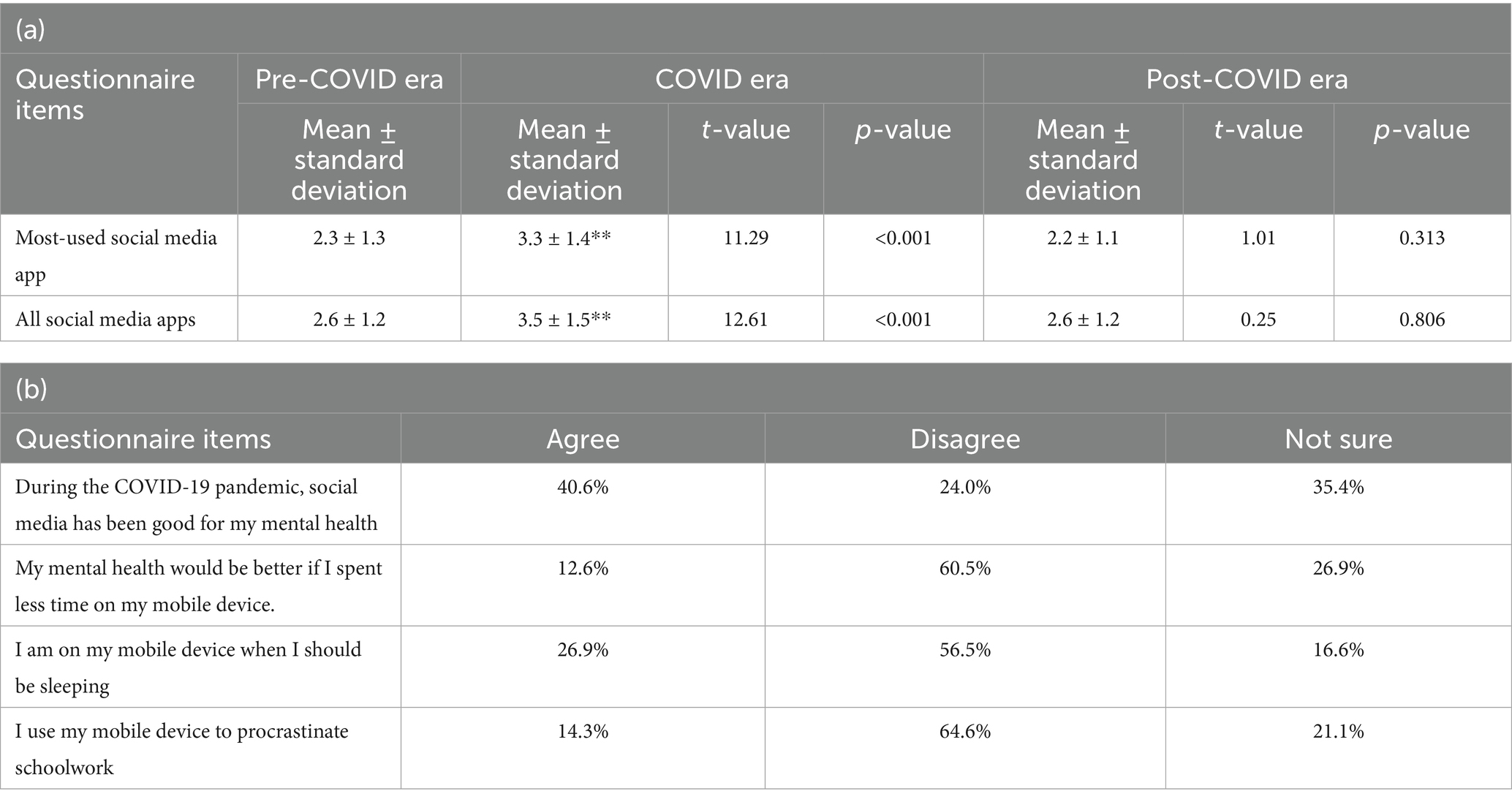
Table 2. (a) Comparison of average daily screen usage for social apps in the COVID and post-COVID era with that in the pre-COVID era using paired t-tests (**p < 0.01); and (b) self-rated impact of screen usage on mental health.
There was no significant difference in the platform of the most-used social media apps (Chi2 = 6.05, p = 0.642) between the two groups with low and high PMH scores, respectively (Figure 1a). The highest proportion of individuals with low PMH scores chose TikTok as their most-used social media app (28.9%), whereas Instagram (36.5%) had the highest proportion with high PMH scores. No significant relationships were found between the type of content consumed on participants’ most-used social media apps and their PMH scores (Figure 1b; Chi2 = 4.92, p = 0.426). The most common type of content consumed by participants on their most-used social media app was entertainment, with 62.2% in the category of low-PMH scores and 55.3% in the category of high-PMH scores.
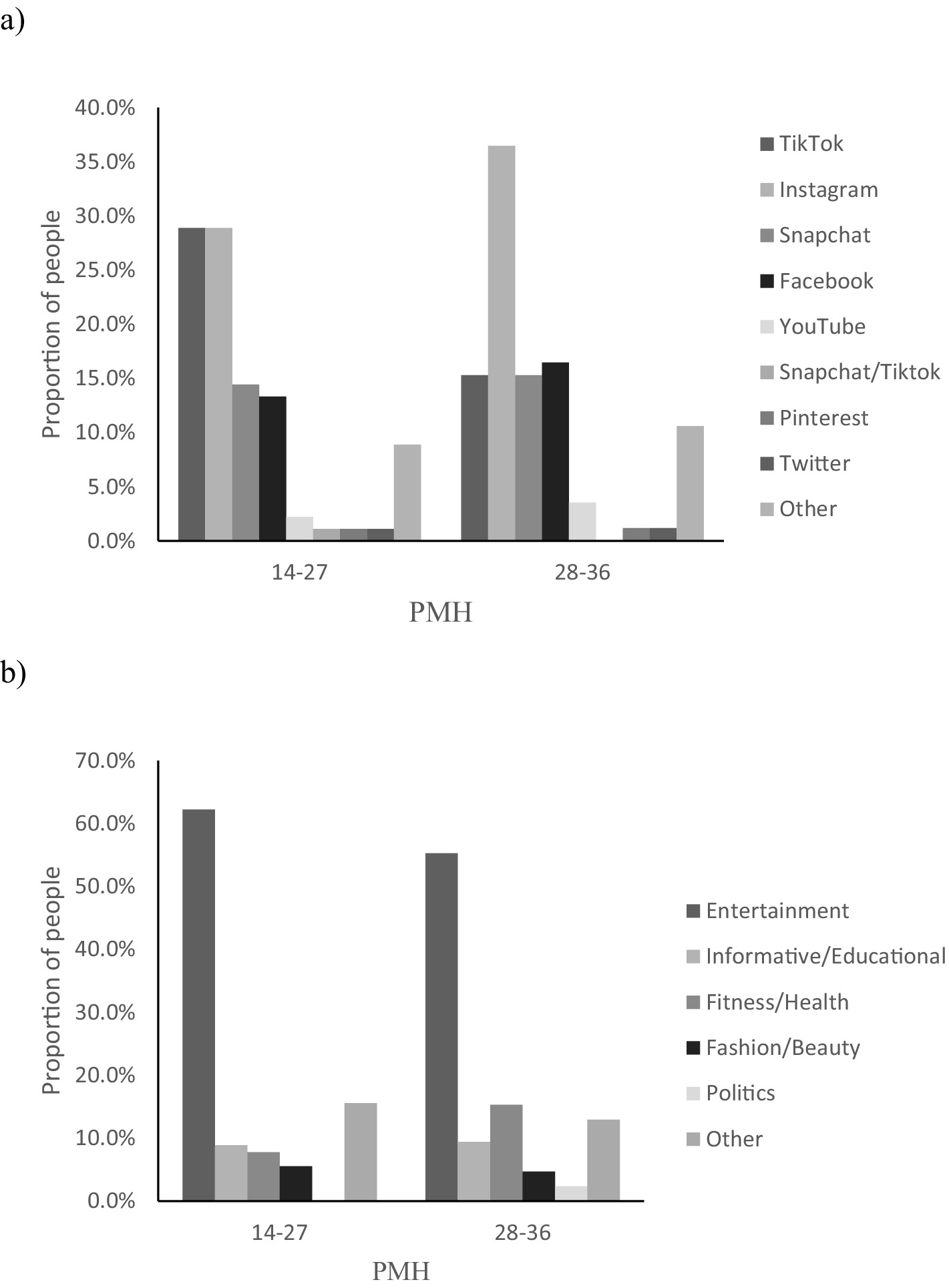
Figure 1. Comparison of (a) platform and (b) content in the most-used social apps between two PMH categories: low and high PMH scores.
Daily screen usage for social media apps increased during the pandemic, and screen usage decreased in the post-COVID era (Figure 2). In both the post- and pre-COVID era, the greatest proportion of the participants (70.3% in the post-COVID era, 62.9% in pre-COVID era) spent no more than 2 h on average daily screen usage for the most-used social media apps, while the greatest proportion (67.4%) spent more than 3 h daily (Figure 2a) during the COVID-19 era. For total social media apps, the greatest proportion (54.3% in the post-COVID era, 52.0% in the pre-COVID era) spent no more than 2 h on average daily screen usage, while the greatest proportion (74.3%) spent more than 3 h daily (Figure 2b) during the COVID-19 era. In all three COVID eras, age, sex, and freshmen did not significantly affect the average daily screen usage for the most-used social media apps (Table 3). Christians had significantly lower daily screen usage for the most-used social media apps than non-Christians did in the entire COVID era. After COVID, non-Caucasian had significantly higher daily screen usage for the most-used social media apps than Caucasians did, which was not the case in either the pre- or the COVID era. Applying both the univariate and multivariate analyses (Table 4), transitions of screen usage during the COVID and post-COVID era for the most-used social media were significantly associated with the effect of baseline social media usage (p < 0.01). Positive mental health (PMH) reduced screen usage for the most-used social media to a certain degree, especially in the post-COVID era, whereas PMH had no effect on their social media usage during the COVID era. The religion factor was consistently associated with decreased screen usage transition in both the COVID and post-COVID era, with the reduction of screen usage being 18% during the pandemic.
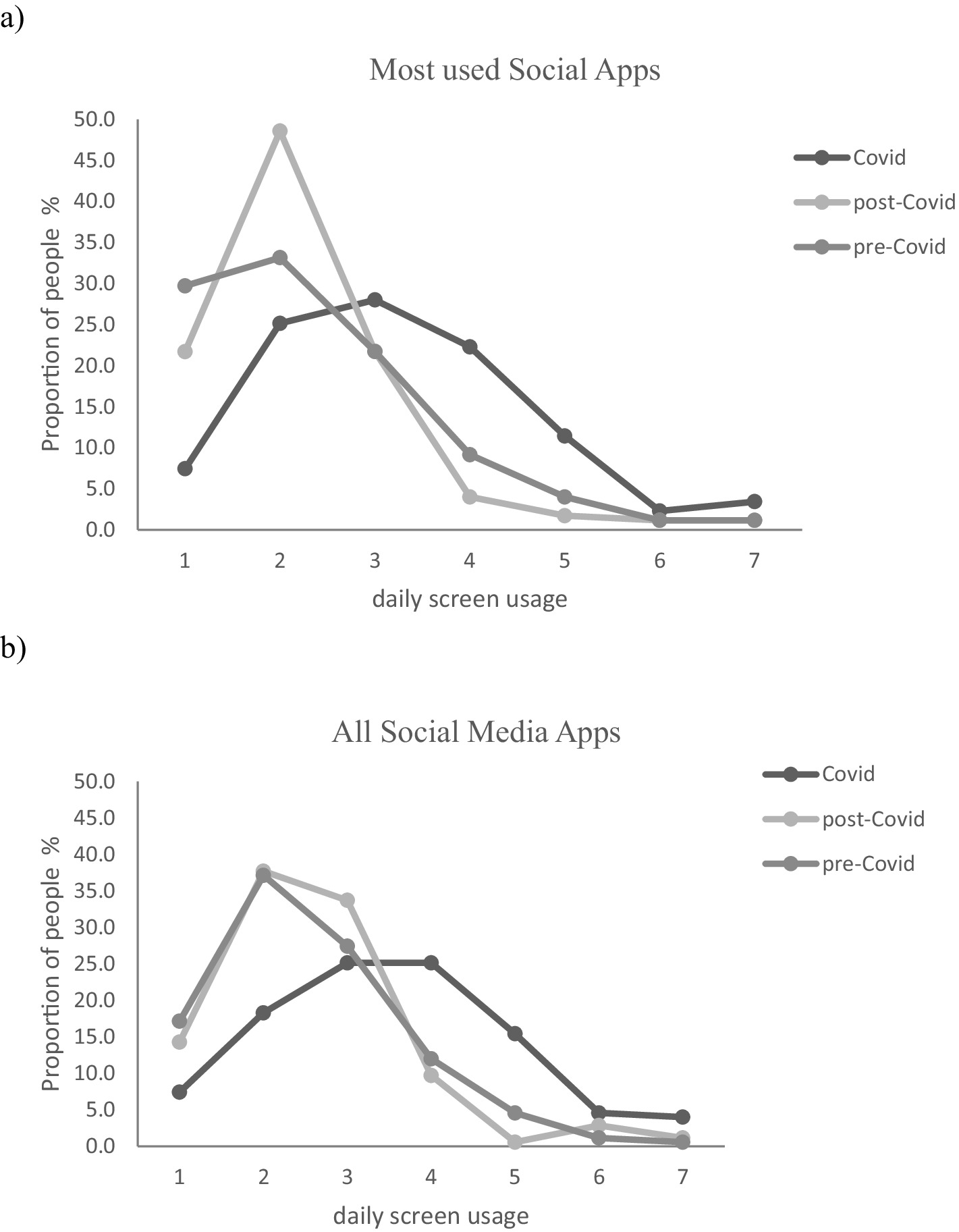
Figure 2. Proportion of people on daily screen usage for: (a) most-used social media apps, (b) all social media apps in the different COVID era.
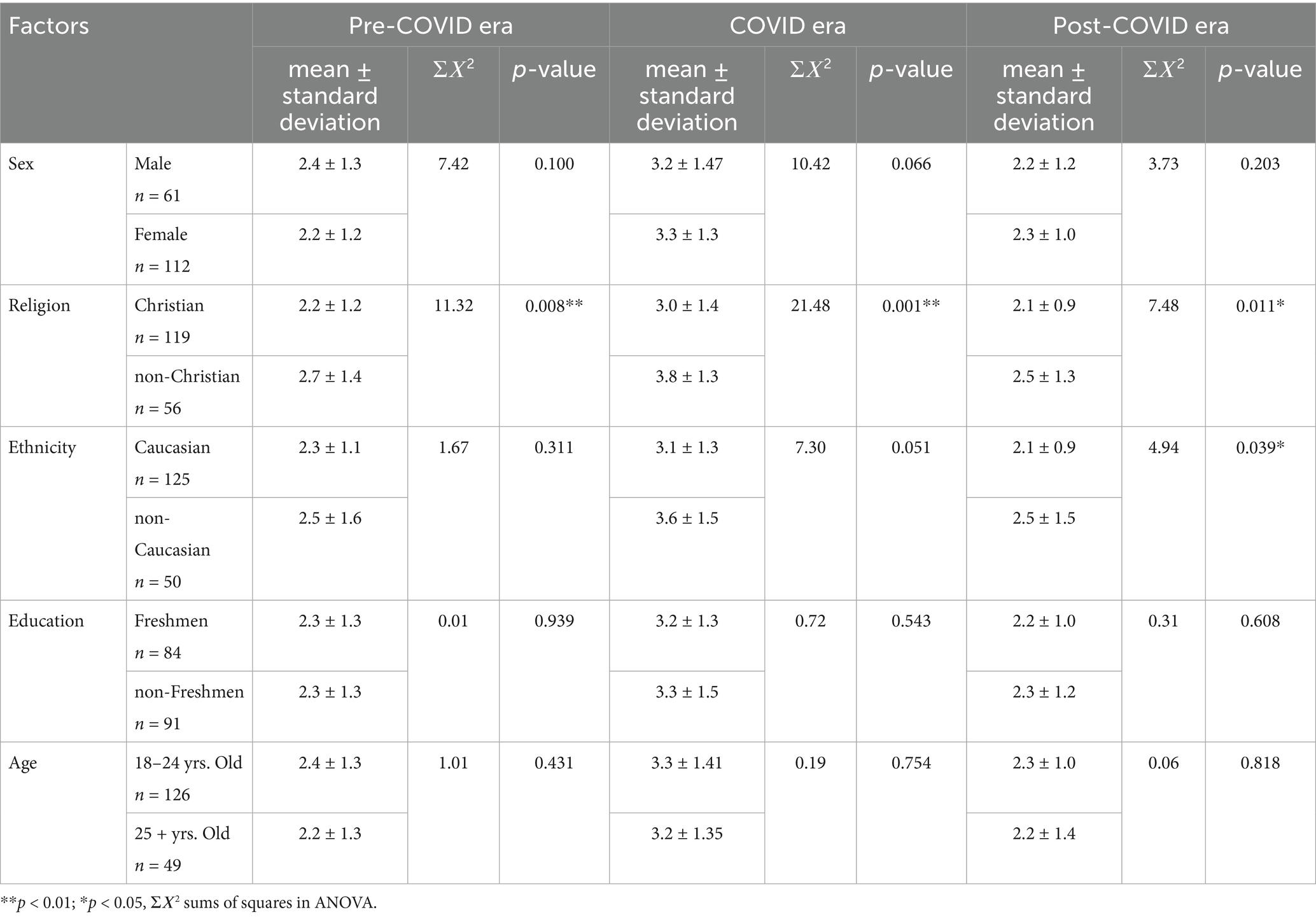
Table 3. Impact of both intrinsic and extrinsic factors on daily screen usage for the most-used social media apps in the different COVID era.
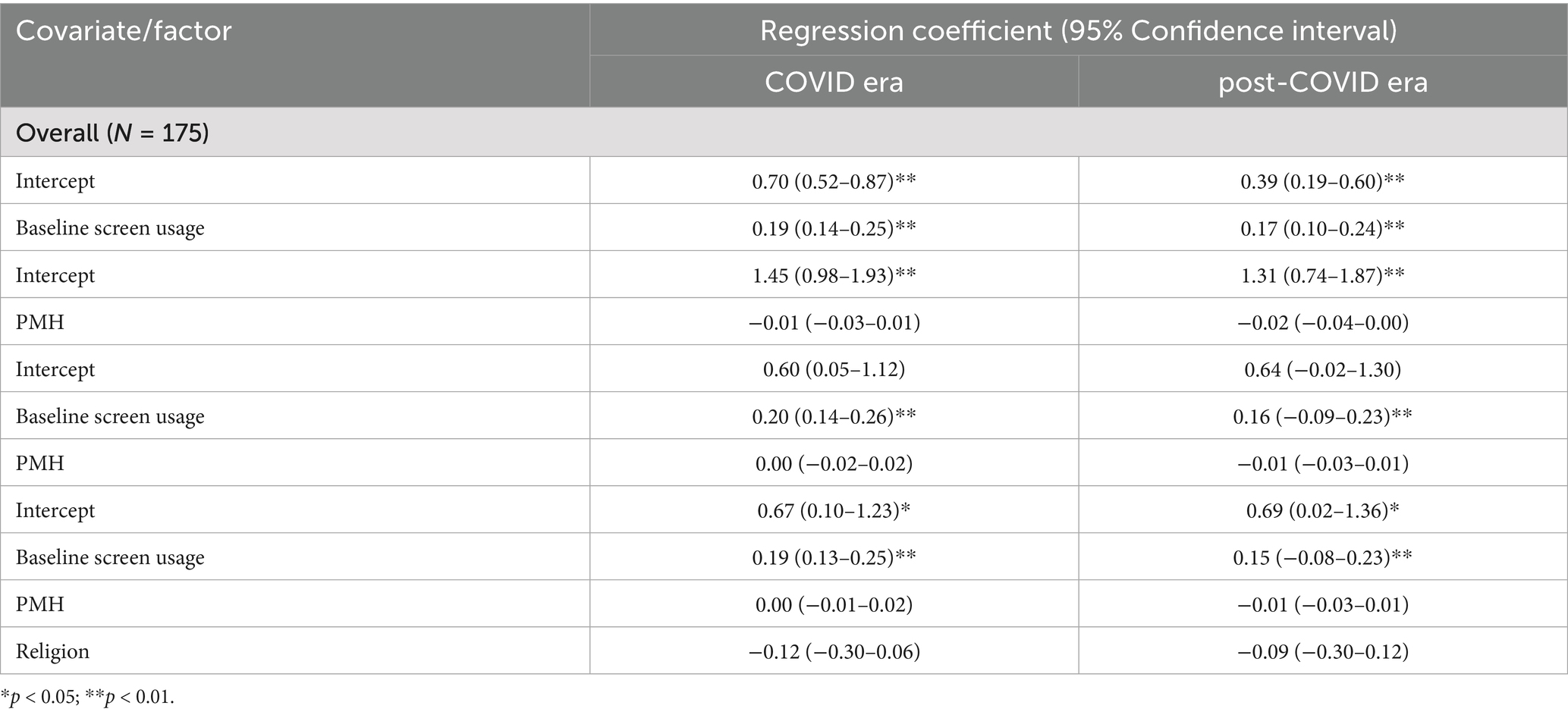
Table 4. Parameter estimates for the effect of the baseline screen usage and PMH on screen usage during the COVID and post-COVID era, respectively (univariable and multivariable Poisson regression).
During both the COVID and post-COVID eras, decreased mean PMH scores were closely related to daily screen usage for all social media apps (Figure 3a). For most-used social media apps, mean PMH scores decreased with increased daily screen usage in the post-COVID era, while such correlation was not present during COVID-19 (Figure 3b). The transition of screen usage during the COVID and post-COVID eras for the most-used social media was compared between the low- and high-PMH groups (Figure 4). During COVID-19, the screen time transition was dominated by increased usage in both groups. For most-used social media apps, a slightly higher proportion of people (61%) in the high-PMH group increased their screen usage than in the low-PMH group (54%). Nevertheless, after COVID, a greater proportion of people (45%) in the high-PMH group transitioned back to the same screen usage in the pre-COVID era as in the low-PMH group (33%) (Figure 4a). For total social media apps, there was a slightly higher proportion of people (44%) in the high-PMH group transitioning back to the same usage in the pre-COVID era than in the low-PMH group (40%) (Figure 4b).
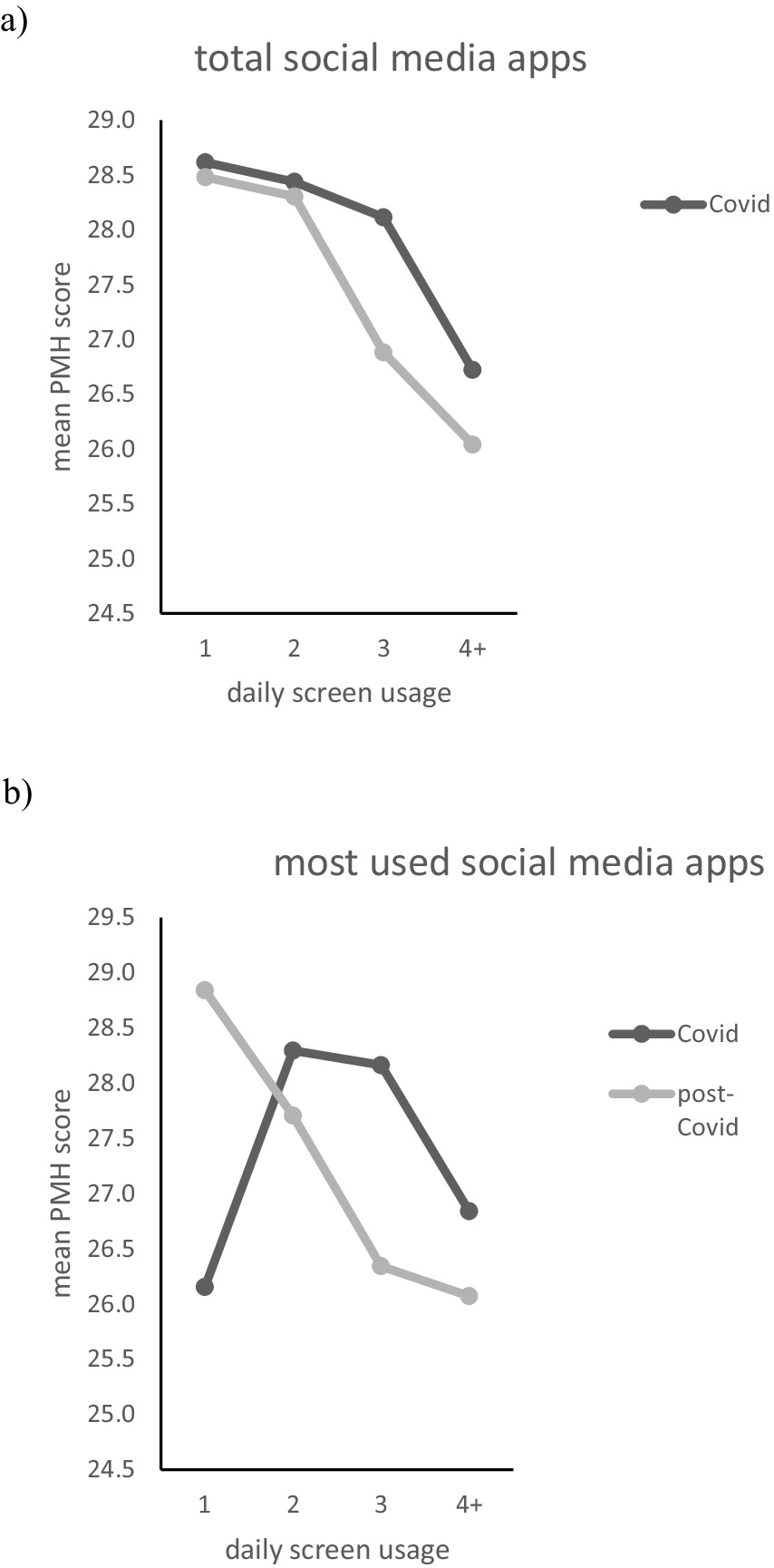
Figure 3. Mean PMH scores as a function of average daily screen usage for: (a) total and (b) most-used social media apps, respectively.
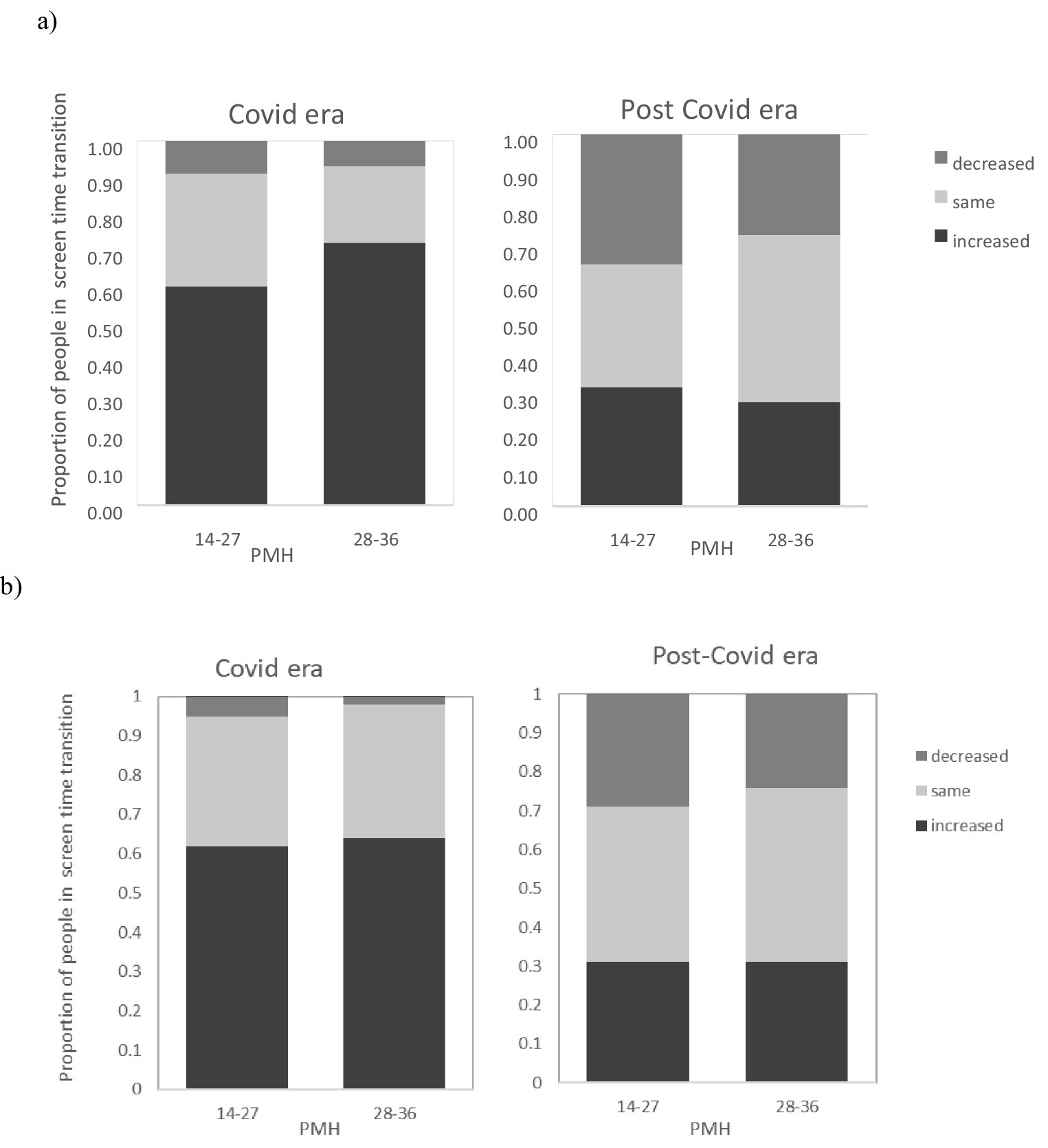
Figure 4. Compare the proportion of people in screen time transition of average daily screen usage for: (a) most-used and (b) total social media apps during the COVID and post-COVID era, with those during the pre-COVID era, respectively, in relation to their PMH scores.
Discussion
In this study, we evaluated both the COVID-impact and its remnant impact on social media usage among undergraduates with different mental health statuses by applying a PMH scale approach. We studied multiple components of social media use, such as content, platforms, and motivation, in relation to mental health. We further examined how multiple factors, such as age, religion, ethnicity, and mental health, affected the remnant COVID-impact on undergraduates’ social media use in a small non-secular university, providing the first investigation of this research line.
TikTok and Instagram were the most commonly used social media platforms among the respondents, with approximately 55.4% of the sample using these platforms daily. With regard to social media platforms in particular, TikTok was chosen most by people with low mental health status, whereas Instagram was chosen most by people with high mental health status (Figure 1a). In addition, the group with high mental health tended to consume more fitness content and less entertainment (Figure 1b), relevant to a less sedentary lifestyle. Consistent with previous research (Riehm et al., 2019), the substantial elevation of social media use identified in the sample during COVID-19 (Table 2a) indicates that social media might play a critical role in the lives of youth during this pandemic era. During the COVID-19 pandemic, 74.3% of the participants spent more than 3 h daily on all social media platforms, while 67.4% spent more than 3 h daily on their most-used social media platform. In the post-COVID era, average daily screen usage for social media reduced greatly, with 70.3% of participants spending no more than 2 h daily on social media. There was no significant discrepancy in the average daily social media use between the pre- and post-COVID era. This may be linked to the Christian orientation of the University and its members, who may provide more community support to each other (Hack-Polay and Brown, 2024).
In line with previous research that heavy daily social media use, for instance, more than 3 h among adolescents, might be a risk factor for mental health problems (Riehm et al., 2019), heavier social media use was associated with lower mental health status (Figure 2). Undergraduates with high PMH scores spent less time on their most-used social media daily than those with low PMH scores (Figure 2a). The perceived COVID-19 impact resulted in elevated daily screen use for all social media, which was associated with higher social media use (Figure 2b). When focusing on individuals’ favorite social platforms, moderate to high screen usage (2–4 h daily on most-used social media apps) was observed in the participants with higher PMH scores, while either the lowest or the highest screen usage was associated with those with lower PMH scores (Figure 3b). The results were further confirmed by the self-rated evaluation that 40.6% of the respondents agreed that social media use had a positive impact on their mental health during COVID-19, while 24.0% disagreed (Table 1). In addition, the majority objected that their mobile device use affected their mental health and sleep. These studies indicate that moderate social media use on specific social platforms can promote mental health against the social isolation and stress generated by the pandemic. COVID-19 impact on students lengthened social media usage in relation to their mental health status, which was detected due to risk mitigation strategies and mandates during the pandemic. It is could be hypothesized that the cancelation of the strategies and mandates, as well as the non-pandemic threat in the post-COVID era, would make the transition of students’ social media usage during the COVID era back to the same level as in the pre-COVID era. Nevertheless, the remnant COVID-impact, defined as the transition of social media usage during the pandemic, remained in the post-COVID era and was quantified by the difference in daily social media usage between the post-COVID era and the pre-COVID era. In the post-COVID era, little remnant COVID impact on overall social media usage in relation to mental health was detected, with a slightly lower (4% less) proportion of the group with low mental health status transitioning back to their daily screen usage in the pre-COVID era than in the group with high mental health status (Figure 4b). When focused on the individual most-used social media, a greater (12% more) proportion of the group in high mental health status transitioned back to their daily screen usage in the pre-COVID era than the group in low mental health status (Figure 4a). We acknowledge the potential influence of previously existing mental health conditions that may have been compounded by the COVID-19 situation, particularly for students with persistent low PMH.
Adolescence (13–18 years) is a critical period for brain development in regions such as the dorsolateral prefrontal cortex (DLPFC) and superior temporal gyrus (STG), which are involved in executive function and self-and social cognition (Gogtay et al., 2004; Giorgio et al., 2010). In the brain development trajectory, an extensive reorganization of neural circuitry occurs in these regions, with significant structural maturation expected between 20 and 25 years (Lebel et al., 2008; Arain et al., 2013). Immaturities of cognitive brain development in adolescents and youth might affect their actual decision-making, which makes them more susceptible to peer and social media influences than adults, especially during the pandemic. Nevertheless, our study demonstrated no significant discrepancy in screen usage for their favorite social media between youth (less than 25 years old) and adults (25 + years old) in different COVID eras. The transition from high school to university was not an extrinsic factor that affected freshmen’s social media usage. No gender differences in social media usage were present in the pre-, during, and post-COVID eras (Table 3). In the post-COVID era, Caucasians spent significantly less time on their most-used social media than non-Caucasians, while ethnicity did not significantly impact social media use in the pre- and during the COVID era. Notably, Christian undergraduates spent significantly less screen time on their most-used social media than non-Christians in all three eras. The reason why Christian respondents spent significantly less time on social media might be that churches and fellowships initiate reliable social connections and safe social engagement.
Our study has some limitations that we acknowledge. First, the respondents’ self-reported outcomes and data were from their own perspectives and might lack objectivity. For instance, with the assistance of mobile apps for phone status, including daily social media usage, recall bias cannot be completely eliminated in this self-rated study. Second, we measured mental health status using a self-report questionnaire, the accuracy of which may not be the same as that of a clinical assessment. Future research on mental health in relation to the use of specific social platforms, considering the remnant COVID impact in clinical settings, will be of particular interest. Third, owing to its unique small Christian identity, the disproportionate demographics of the study are an accurate representation of the population of students at the Christian university studied (for example, more women and Christian students). It is acknowledged that the results might not be generalizable beyond this sub-group of Canadian undergraduates. Despite these limitations, our study demonstrated consistent results, such as increased social media use during COVID-19 and its detrimental impact on people’s mental health, in line with previous publications (Li et al., 2021; Lee et al., 2022).
Conclusion
This study aimed to test the presence of positive mental health status among undergraduate students using the Positive Mental Health Scale (PMH). The use of this scale is justified by the fact that it provides clearer descriptive results for the study participants and their mental well-being state.
When grouping together multiple platforms, the COVID-impact resulted in higher screen time for all social media usage daily among the undergraduates with lower mental health status, and the remnant impact in the post-COVID era decreased for all the participants in this study, with little discrepancy between low and high mental health status. When focused on the individual most-used platform, moderate to high screen use (1–4 h daily) was associated with better mental health status when compared with extremely low (less than 1 h daily) or heavy screen use (more than 4 h daily) during the pandemic. In post-COVID era, a higher screen time for the most-used social media is associated with a lower mental health status. The remnant impact of the pandemic was higher in participants with low mental health status in their screen use for most platforms. However, religion was tested and appeared to be a protective factor against excessive screen usage on social media in all three eras.
Implications of the study
Therefore, providing public health policies and guidance associated with health challenges from social media use, social media can promote mental health and protect people from the COVID-19 negative impact. Universities’ counselling systems also need to be strengthened to now recognize the possibility of pandemic effects. These initiatives could start at the middle and high school levels and involve teachers, parents, and students. This will prepare the students to assume their independence as young learners when they enter university, where parental and school supervision is reduced. Universities also play a role in providing students with awareness of the negative ramifications of excessive screen time, particularly during crises or pandemics. More investment could be made in creating and stimulating physical and creative activities that take students away from unnecessary screen time, for example, preparing a presentation without visual aids. In this way, when another pandemic occurs, students will be educated on the course of action to maintain positive mental health away from the screen.
Limitations and further studies
Gender, ethnicity, and age differences were not detected in screen usage for COVID-19 or its residual impact. This may be linked to our sample size, which may have been greater and more balanced. Future studies may need to consider a wider cross-sectional survey with potential regional, national, or international comparisons. The outcomes of such studies will be more generalizable and provide learning that has a wider reach.
Data availability statement
The raw data supporting the conclusions of this article will be made available by the authors, without undue reservation.
Ethics statement
The studies involving humans were approved by Crandall University Research Ethics Committee. The studies were conducted in accordance with the local legislation and institutional requirements. The participants provided their written informed consent to participate in this study.
Author contributions
ZY: Conceptualization, Formal analysis, Investigation, Methodology, Supervision, Writing – original draft. SG: Conceptualization, Formal analysis, Investigation, Resources, Writing – review & editing. MS: Formal analysis, Writing – review & editing, Conceptualization, Investigation, Resources. DH-P: Conceptualization, Formal analysis, Writing – review & editing, Data curation, Validation. BZ: Formal analysis, Writing – review & editing, Validation, Visualization.
Funding
The author(s) declare that no financial support was received for the research and/or publication of this article.
Conflict of interest
The authors declare that the research was conducted in the absence of any commercial or financial relationships that could be construed as a potential conflict of interest.
Generative AI statement
The authors declare that no Gen AI was used in the creation of this manuscript.
Any alternative text (alt text) provided alongside figures in this article has been generated by Frontiers with the support of artificial intelligence and reasonable efforts have been made to ensure accuracy, including review by the authors wherever possible. If you identify any issues, please contact us.
Publisher’s note
All claims expressed in this article are solely those of the authors and do not necessarily represent those of their affiliated organizations, or those of the publisher, the editors and the reviewers. Any product that may be evaluated in this article, or claim that may be made by its manufacturer, is not guaranteed or endorsed by the publisher.
References
Almubaddel, A. (2022). Psychometric properties of a Saudi Arabian version of the positive mental health (PMH) scale. Psicol. Refl. Crít. 35:29 (2022). doi: 10.1186/s41155-022-00232-0
Arain, M., Haque, M., Johal, L., Mathur, P., Nel, W., Rais, A., et al. (2013). Maturation of the adolescent brain. Neuropsychiatr. Dis. Treat. 9, 449–461. doi: 10.2147/NDT.S39776
Babic, M. J., Smith, J. J., Morgan, P. J., Eather, N., Ronald, C., Plotnikoff, R. C., et al. (2017). Longitudinal associations between changes in screen-time and mental health outcomes in adolescents. Mental Health and Physical Activity. 12, 124–131. doi: 10.1016/j.mhpa.2017.04.001
Barbayannis, G., Bandari, M., Zheng, X., Baquerizo, H., Pecor, K. W., and Ming, X. (2022). Academic Stress and Mental Well-Being in College Students: Correlations, Affected Groups, and COVID-19. Front. Psychol. 13:886344. doi: 10.3389/fpsyg.2022.886344
Boers, E., Afzali, M. H., Newton, N., and Conrod, P. (2019). Association of Screen Time and Depression in Adolescence. JAMA Pediatr. 173, 853–859. doi: 10.1001/jamapediatrics.2019.1759
Casey, B. J., Jones, R. M., and Hare, T. A. (2008). The adolescent brain. Ann. N. Y. Acad. Sci. 1124, 111–126. doi: 10.1196/annals.1440.010
Colley, R. C., Lang, J. J., Saunders, T. J., Roberts, K. C., Butler, G. P., and Prince, S. A. (2022). How sedentary are Canadian adults? It depends on the measure. Health Rep. 33, 14–27. doi: 10.25318/82-003-x202201000002-eng
Giorgio, A., Watkins, K. E., Chadwick, M., James, S., Winmill, L., Douaud, G., et al. (2010). Longitudinal changes in grey and white matter during adolescence. NeuroImage 49, 94–103. doi: 10.1016/j.neuroimage.2009.08.003
Gogtay, N., Giedd, J. N., Lusk, L., Hayashi, K. M., Greenstein, D., Vaituzis, A. C., et al. (2004). Dynamic mapping of human cortical development during childhood through early adulthood. Proc. Natl. Acad. Sci. U. S. A. 101, 8174–8179. doi: 10.1073/pnas.0402680101
Guerrero, M. D., and Barnes, J. D. (2022). Profiles of mental health and their association with negative impacts and suicidal ideation during the COVID-19 pandemic: a Canadian perspective. Health Rep. 33, 19–30. doi: 10.25318/82-003-x202200800002-eng
Hack-Polay, D. (2020). Global south expatriates, homesickness and adjustment approaches. Public Health Rev. 41:11. doi: 10.1186/s40985-020-00122-9
Hack-Polay, D., and Brown, D. (2024). International students’ stories of pandemic self-isolation: perspectives at a Christian university. Christ. High. Educ. 24, 38–53. doi: 10.1080/15363759.2024.2392273
Hack-Polay, D., and Read, M. (2019). Accelerated two-year degrees in the UK: potential impact on student mental health. J. Public Ment. Health 19, 27–34. doi: 10.1108/JPMH-05-2019-0057
Jasbi, P., Mohr, A. E., Shi, X., Mahmood, T., Zhu, Q., Bruening, M., et al. (2022). Microbiome and metabolome profiles of high screen time in a cohort of healthy college students. Sci Rep. 12:3452. doi: 10.1038/s41598-022-07381-3
Kelly, Y., Zilanawala, A., Booker, C., and Sacker, A. (2018). Social media use and adolescent mental health: findings from the UK millennium cohort study. EClinicalMedicine. 6, 59–68. doi: 10.1016/j.eclinm.2018.12.005
Kingsbury, M., Reme, B. A., Skogen, J. C., Sivertsen, B., Øverland, S., Cantor, N., et al. (2021). Differential associations between types of social media use and university students’ non-suicidal self-injury and suicidal behavior. Computers in Human behavior. 115:106614. doi: 10.1016/j.chb.2020.106614
Lebel, C., Walker, L., Leemans, A., Phillips, L., and Beaulieu, C. (2008). Microstructural maturation of the human brain from childhood to adulthood. NeuroImage 40, 1044–1055. doi: 10.1016/j.neuroimage.2007.12.053
Lee, Y., Jeon, Y. J., Kang, S., Shin, J. I., Jung, Y. C., and Jung, S. J. (2022). Social media use and mental health during the COVID-19 pandemic in young adults: a meta-analysis of 14 cross-sectional studies. BMC Public Health 22:995. doi: 10.1186/s12889-022-13409-0
Leppänen, M. H., Sääksjärvi, K., Vepsäläinen, H., Ray, C., Hiltunen, P., Koivusilta, L., et al. (2020). Association of screen time with long-term stress and temperament in preschoolers: results from the DAGIS study. Eur. J. Pediatr. 179, 1805–1812. doi: 10.1007/s00431-020-03686-5
Li, X., Vanderloo, L. M., Keown-Stoneman, C. D. G., Cost, K. T., Charach, A., Maguire, J. L., et al. (2021). Screen use and mental health symptoms in Canadian children and youth during the COVID-19 pandemic. JAMA Netw. Open 4:e2140875. doi: 10.1001/jamanetworkopen.2021.40875
Lissak, G. (2018). Adverse physiological and psychological effects of screen time on children and adolescents: literature review and case study. Environ. Res. 164, 149–157. doi: 10.1016/j.envres.2018.01.015
Lovin, D., and Bernardeau-Moreau, D. (2022). Stress among Students and Difficulty with Time Management: A Study at the University of Galați in Romania. Social Sciences, MDPI 11, 1–13. doi: 10.3390/socsci11120538
Lukat, J., Margraf, J., Lutz, R., van der Veld, W. M., and Becker, E. S. (2016). Psychometric properties of the positive mental health scale (PMH-scale). BMC Psychol. 4:8. doi: 10.1186/s40359-016-0111-x
Neophytou, E., Manwell, L. A., and Eikelboom, R. (2021). Effects of excessive screen time on neurodevelopment, learning, memory, mental health, and neurodegeneration: a scoping review. Int. J. Ment. Health Addict. 19, 724–744. doi: 10.1007/s11469-019-00182-2
Ngien, A., and Jiang, S. (2022). The effect of social media on stress among young adults during COVID-19 pandemic: taking into account fatalism and social media exhaustion. Health Commun. 37, 1337–1344. doi: 10.1080/10410236.2021.1888438
O’Reilly, M., Dogra, N., Hughes, J., Reilly, P., George, R., and Whiteman, N. (2019). Potential of social media in promoting mental health in adolescents. Health Promot. Int. 34, 981–991. doi: 10.1093/heapro/day056
Pandya, A., and Lodha, P. (2021). Social Connectedness, Excessive Screen Time during COVID-19 and Mental Health: A Review of Current Evidence. Frontiers in Human Dynamics 3:684137. doi: 10.3389/fhumd.2021.684137
Popat, A., and Tarrant, C. (2022). Exploring adolescents’ perspectives on social media and mental health and well-being–a qualitative literature review. Clin. Child Psychol. Psychiatry 28, 323–337. doi: 10.1177/13591045221092884
Riehm, K. E., Feder, K. A., Tormohlen, K. N., Crum, R. M., Young, A. S., Green, K. M., et al. (2019). Associations between time spent using social media and internalizing and externalizing problems among US youth. JAMA Psychiatr. 76, 1266–1273. doi: 10.1001/jamapsychiatry.2019.2325
Royant-Parola, S., Londe, V., Tréhout, S., and Hartley, S. (2018). Nouveaux médias sociaux, nouveaux comportements de sommeil chez les adolescents [The use of social media modifies teenagers' sleep-related behavior]. L'Encephale 44, 321–328. doi: 10.1016/j.encep.2017.03.009
Saunders, T. J., McIsaac, T., Douillette, K., Gaulton, N., Hunter, S., Rhodes, R. E., et al. (2020). Sedentary behaviour and health in adults: an overview of systematic reviews. Appl Physiol Nutr Metab. 45, S197–S217. doi: 10.1139/apnm-2020-0272
Statistics Canada (2022). Youth mental health in the spotlight again, as pandemic drags on : StatsCAN Plus. Available at: https://www.statcan.gc.ca/o1/en/plus/907-youth-mental-health-spotlight-againpandemic-drags
Tremblay, M. S., Chaput, J. P., Adamo, K. B., Salomé, A., Joel, D. B., Louise, C., et al. (2017). Canadian 24-Hour Movement Guidelines for the Early Years (0-4 years): An Integration of Physical Activity, Sedentary Behaviour, and Sleep. BMC public health 17, 874–906. doi: 10.1186/s12889-017-4859-6
Trott, M., Driscoll, R., Irlado, E., and Pardhan, S. (2022). Changes and correlates of screen time in adults and children during the COVID-19 pandemic: a systematic review and meta-analysis. Changes and correlates of screen time in adults and children during the COVID-19 pandemic: a systematic review and meta-analysis. EClinicalMedicine 48:101452. doi: 10.1016/j.eclinm.2022.101452
Twenge, J. M., and Campbell, W. K. (2018). Associations between screen time and lower psychological well-being among children and adolescents: evidence from a population-based study. Prev. Med. Rep. 12, 271–283. doi: 10.1016/j.pmedr.2018.10.003
Vaganian, L., Boecker, M., Bussmann, S., Kusch, M., Labouvie, H., Margraf, J., et al. (2022). Psychometric evaluation of the positive mental health (PMH) scale using item response theory. BMC Psychiatry 22:512. doi: 10.1186/s12888-022-04162-0
Velten, J., Brailovskaia, J., and Margraf, J. (2022). Positive mental health scale: validation and measurement invariance across eight countries, genders, and age groups. Psychol. Assess. 34, 332–340. doi: 10.1037/pas0001094
Wang, Y. (2023). The research on the impact of distance learning on students’ mental health. Educ Inf Technol (Dordr). 11, 1–13. doi: 10.1007/s10639-023-11693-w
Wang, X., Li, Y., and Fan, H. (2019). The associations between screen time-based sedentary behavior and depression: a systematic review and meta-analysis. BMC Public Health 19, 1524–1529. doi: 10.1186/s12889-019-7904-9
Woods, H. C., and Scott, H. (2016). Sleepyteens: social media use in adolescence is associated with poor sleep quality, anxiety, depression and low self-esteem. J. Adolesc. 51, 41–49. doi: 10.1016/j.adolescence.2016.05.008
Xu, J., and Yang, X. (2024). The influence of resilience on stress reaction of college students during COVID-19: the mediating role of coping style and positive adaptive response. Curr Psychol. 43, 12120–12131. doi: 10.1007/s12144-022-04214-4
Yang, L., Yang, Z., and Xia, Y. (2022). Relationship between negative coping style and fear of COVID-19 among Wuhan college students during the post-pandemic period: A moderated chain mediation model. Front Psychiatry. 13:994685. doi: 10.3389/fpsyt.2022.994685
Keywords: screen usage, social media, mental health, undergraduates, Christian university
Citation: Yang Z, Gray S, Sparkes M, Hack-Polay D and Zhou B (2025) Influence of COVID-19 on social media usage: association with mental well-being in undergraduate students. Front. Educ. 10:1645780. doi: 10.3389/feduc.2025.1645780
Edited by:
Tour Liu, Tianjin Normal University, ChinaReviewed by:
Wahyu Rahardjo, Gunadarma University, IndonesiaAlex Audu, Federal Neuropsychiatric Hospital, Nigeria
Copyright © 2025 Yang, Gray, Sparkes, Hack-Polay and Zhou. This is an open-access article distributed under the terms of the Creative Commons Attribution License (CC BY). The use, distribution or reproduction in other forums is permitted, provided the original author(s) and the copyright owner(s) are credited and that the original publication in this journal is cited, in accordance with accepted academic practice. No use, distribution or reproduction is permitted which does not comply with these terms.
*Correspondence: Dieu Hack-Polay, ZGlldS5oYWNrLXBvbGF5QGNyYW5kYWxsdS5jYQ==
 Zhan Yang
Zhan Yang Sophie Gray1
Sophie Gray1 Dieu Hack-Polay
Dieu Hack-Polay